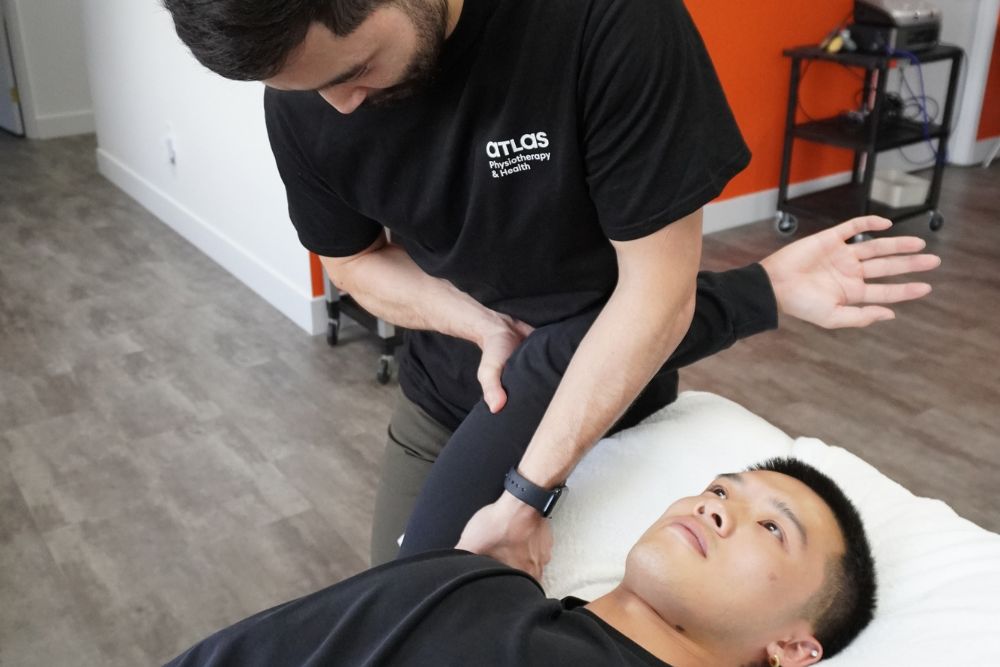Physiotherapists are experts in helping people recover from injuries and painful conditions.
They assist people at every point in the healthcare process, from early detection and prevention to intervention, treatment, and rehabilitation.
If an injury or condition hinders your mobility or daily activities, your doctor will probably suggest seeing a physiotherapist for treatment.
In fact, almost everyone will need to see a physiotherapist at some point in life—whether it’s helping patients recover from an injury or surgery, reducing pain, or regaining mobility.
Physical therapists help people of all ages and abilities by taking a varied approach that includes the patient’s mental, emotional, and social well-being as well as their physical health.
What is Physiotherapy?
Physiotherapy is a healthcare profession that focuses on the diagnosis, management, and prevention of movement-related conditions.
Physiotherapists assess and treat patients using various clinical practices, including manual therapy, exercise prescription, and education.
While considering variances in health conditions, physiotherapy concentrates on promoting health, injury prevention, intervention, treatment, habilitation, and rehabilitation.
However, many people often confuse chiropractic and physiotherapy.
When it comes to considering chiropractors vs. physiotherapists, both play roles in promoting health. They also both treat the musculoskeletal system.
But where chiropractic treatment focuses on spinal adjustments, physiotherapists use a broader range of therapies.
What Is the Role of Physiotherapists?
Those who practice physiotherapy have extensive medical training and an in-depth understanding of how the body functions.
Physical therapists use their hands-on expertise to evaluate patients, identify problems, and provide care for those who are ailing or physically challenged.
They are healthcare professionals who use exercise, mobilization techniques, and other treatments to improve mobility, decrease pain, and prevent or limit permanent damage to the body.
A physiotherapist may work in a variety of settings. They can assess and treat in hospitals, private clinics, and community health centers.
They can also work as part of a collaborative team in a hospital or clinic or as part of a group of professionals who provide care in the community.
Long-term care facilities, rehab centers, home care programs, schools, public health centers, child development centers, recreation centers, sports clinics and facilities, and universities are some of the places you might find a physiotherapist at work.
Physiotherapists perform a variety of duties. They might assess patients to diagnose health concerns and create treatment plans.
They may help clients relieve pain, strengthen muscles, and improve coordination. They also might help clients learn to walk again after an injury or illness has left them unable to do so.
Physiotherapists do more than only treat patients physically; they also teach individuals, families, and communities about injury prevention and how to better care for themselves.
Massage, electrical muscle stimulation, joint manipulation, and muscle stretching are all examples of their manual techniques.
Physiotherapists serve a wide variety of patients, including those with developmental challenges, premature babies, pregnant women, those needing general physical therapy, athletes, the elderly, and those recovering from heart disease, stroke, or major surgery.
What Are the Required Educational Qualifications for Physiotherapists?
All physiotherapists in Canada are required to get a license from the College of Physiotherapists before they may treat patients.
Before being allowed to practice, they must pass a standardized competency assessment and demonstrate that they have met national entry-level education and practice standards.
Obtaining a master’s degree in physiotherapy is now the required minimum level of education for admittance into the field.
Previously, only an undergraduate degree was needed.
Pathology, anatomy, movement science, and physiology are only a few prerequisite courses for the master’s degree.
Physical therapists must complete at least 1,000 hours of clinical practice, ranging from laboratory work to paid internships to collaborative team projects.
What Is the Difference Between a Physical Therapist and a Physiotherapist?
The terms “physiotherapist” and “physical therapist” are synonymous and can be used interchangeably to describe the same profession.
There is a subtle distinction between the two, although it is essentially a matter of regional preference.
Physiotherapists, for instance, are the common name for this profession in places like Canada, Australia, and Europe.
On the other hand, they are called physical therapists in the United States.
For those who want to dig a little deeper, some experts argue that physiotherapy is primarily concerned with manual therapy, whereas physical therapy is more about exercise.
Regardless of the label used, the primary goals of both are the same: to help people avoid injuries, increase their range of motion, and cope with discomfort.
Talk to a professional physiotherapist about your treatment options if you want to increase your mobility and improve your quality of life.
What Are the Advantages of Physiotherapy?
People of any age with mobility issues due to sickness, injury, or other medical conditions can benefit from seeing a physiotherapist.
Through therapeutic exercise and advice on modifying one’s lifestyle, patients in physical therapy can boost their health and avoid additional damage.
Physiotherapy is often the first course of action when a patient has physical issues.
It’s not just about relieving back pain and muscle strain. There are several additional advantages to physiotherapy:
-
Avoiding surgery: It can aid in the healing of injuries and prevent the need for surgery, but if surgery is necessary, physiotherapy can help strengthen the affected area and speed up recovery.
-
Reducing and eliminating pain: It comprises a range of methods and exercises that can assist in reducing discomfort and restoring motion and function to speed up the healing process.
-
Rehabilitation after a sports injury: Expert therapists are familiar with the hazards associated with various sports and can create remedial or preventative fitness routines accordingly.
-
Prevent sports injury: Physiotherapy can help improve your athletic performance by strengthening muscles to make them more efficient at performing their specific tasks during exercise or competition.
-
Improved mobility: standing, moving, and walking difficulties can affect anyone, regardless of age. Improve your mobility with the help of a physiotherapist, who can create a personalized treatment plan just for you.
-
Manage age-related difficulties: As people age, they are more likely to develop joint mobility problems that may necessitate joint replacement. Physiotherapists can facilitate recovery from these treatments and aid in managing age-related conditions.
-
Women’s Health: Particular health issues that affect women include fibromyalgia, pelvic discomfort, breast cancer, pregnancy, and postpartum care. Physiotherapists have the expertise to provide specialized care for challenges unique to women’s health.
Physiotherapists Are Here For You
A physiotherapist can play a crucial role in addressing and preventing both lifestyle-induced strains and injuries resulting from sports activities or accidents.
Whether you’re currently experiencing pain or seeking to enhance your overall body health, reaching out to a physiotherapist can be incredibly beneficial.
If you’re looking for the right treatment option tailored to your specific needs, we invite you to visit our physiotherapy clinic in Markham.
Our team of skilled professionals is dedicated to providing personalized care and guiding you toward optimal well-being.
Don’t let pain or physical limitations hold you back any longer. Take the first step towards a healthier, more active lifestyle by contacting Atlas Physiotherapy & Health today!


















